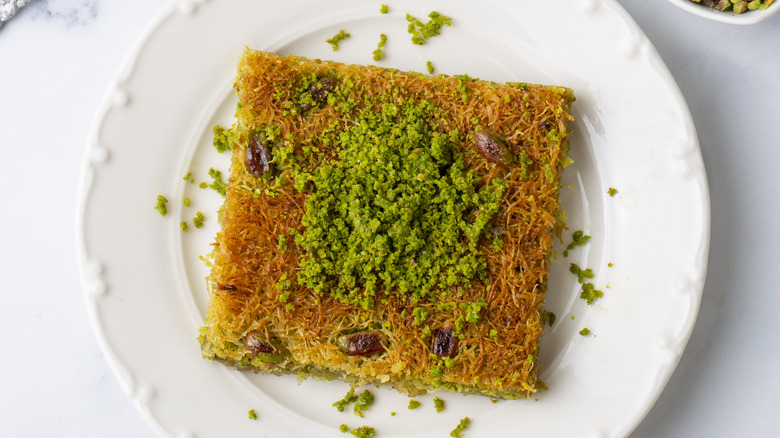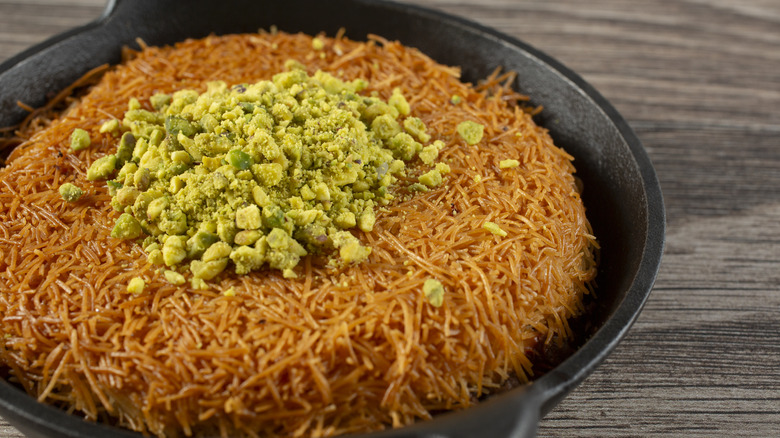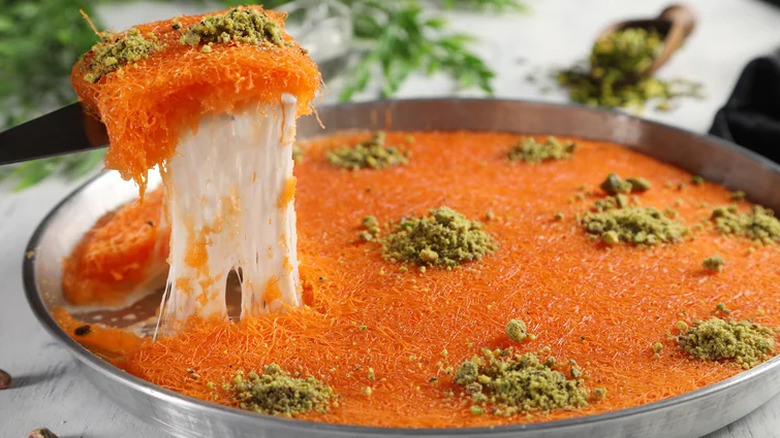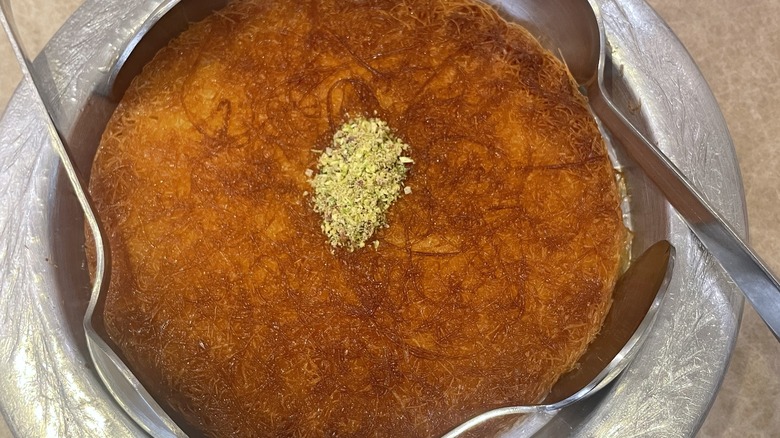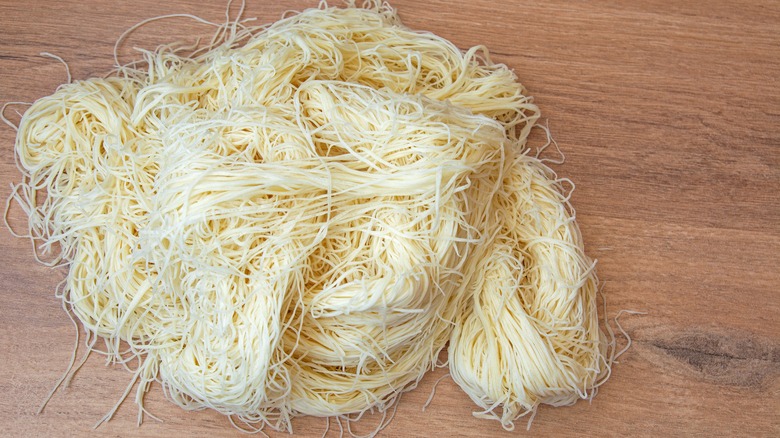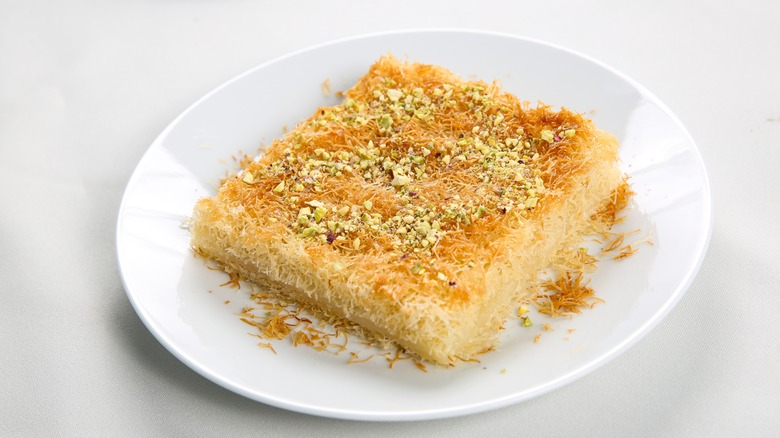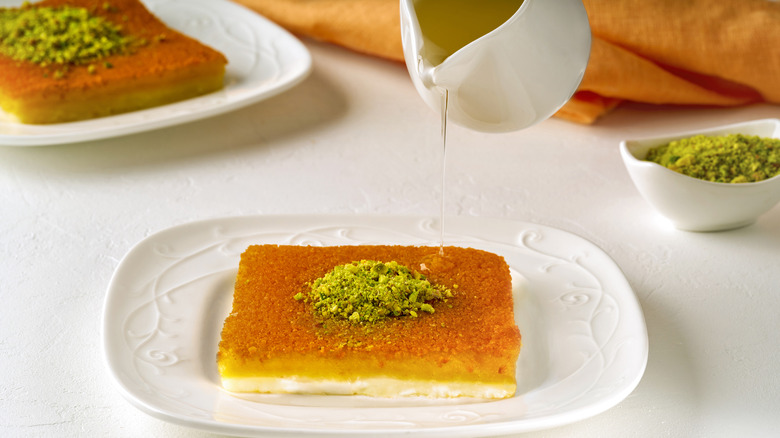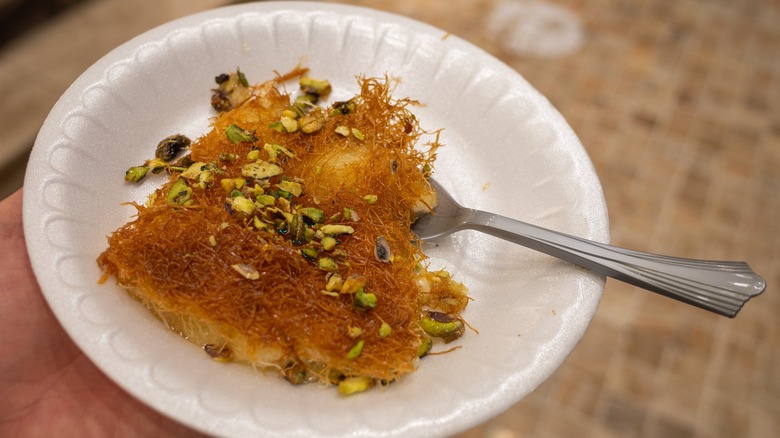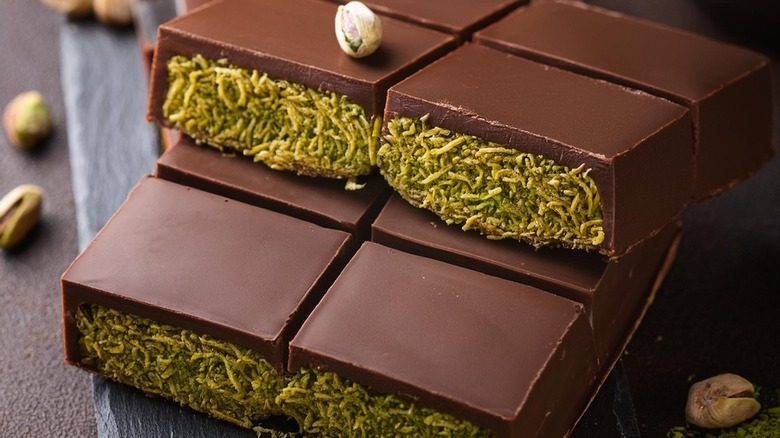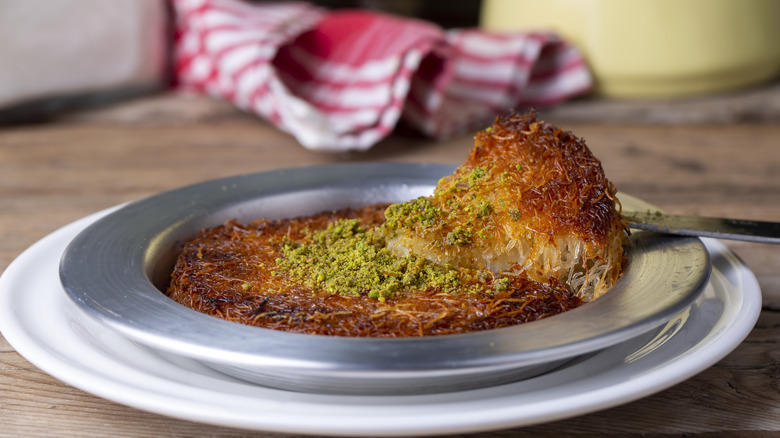Everything You Need To Know About Knafeh, Explained
Middle Eastern desserts, or desserts hailing from South West Asia and North Africa (SWANA), are some of the most intricate looking and impressive treats out there. It's difficult to characterize them all together, as they differ in technique, ingredients, textures, tastes, and more. However, some desserts — like knafeh, basbousa, and baklava — are popular around the world, and they've come to define the iconic goodies from this region. Knafeh, especially, has gained a kind of cult following in recent years, as SWANA cafes and bakeries specializing in knafeh have popped up in the U.S. and abroad to feed the growing demand.
As an Egyptian food writer and recipe developer, knafeh (or kunafa, as it's called in Egypt) has been a part of my life since I was a child. As one of my favorite desserts that my mother made, it was always the dish to take to an aunt's house for a gathering, or to make for a special occasion. Knafeh was also one of the first desserts I learned to make for my food business, and it became one of my top sellers.
Knafeh may look incredibly complicated — so much so that many folks are too intimidated to even attempt making it at home, leaving it to the professionals. But in truth, putting together this dessert is deceptively simple. So, if you're new to the world of knafeh and are wondering what goes into creating this treat, here's everything you need to know about it.
What is knafeh?
Knafeh consists of layers of crispy shredded dough, a filling, and sugar syrup. It's also often garnished with crushed pistachios. Its name might be pronounced slightly differently depending on which country you're in or talking about, and this might also dictate different fillings or methods of preparation. Depending on the type of knafeh, the filling can consist of anything from gooey, melted cheese, a creamy center, or a mixture of nuts.
However, the most elusive part about knafeh is the shredded dough. This angel hair-like pastry is also called something different depending on where in the world you are — but it goes by names like kataifi, kadaif, kadayifi, or, confusingly, even by knafeh or kunafa. This pastry is usually made from a wet dough that's been piped or spun into very thin strands and then cooked on a hot plate. These strands are then gathered into bundles to form the kataifi "nest" that's used to make knafeh and various other foods.
For knafeh, the kataifi is usually drizzled with butter or ghee, and then baked or toasted until crisp and golden brown. The dessert is sometimes colored a deep orange for extra drama. And while it's most commonly served in a large circular metal dish and cut up into slices, you can also find mini-sized, individual knafeh desserts, too.
What does it taste like?
If you ask anyone with Middle Eastern heritage about what knafeh tastes like, you'll likely get a dreamy-eyed response and lots of romantic ways to describe it. In fact, it's difficult to articulate exactly how knafeh tastes, as it's relatively incomparable to anything else. It's buttery, toasty, sweet, and rich, but light. It sometimes has a floral aroma depending on whether the syrup has been scented with orange blossom or rose water. The taste will also depend on the filling, whether it has a mildly sweet, salty, or creamy direction due to the inclusion of cream or cheese. While it is usually drenched in a sweet syrup, if it's done right, even someone without a sweet tooth would enjoy it.
While taste is really essential to why people love knafeh so much, texture is perhaps on the same level of importance. There are different types of knafeh textures, but for the most common type of knafeh you'll find, the knafeh dough ideally needs to have a perfect balance between crispy and soft. The exterior usually has a solid crunch, while the dough closer to the center is a bit softer, creating the chewy feel that people love.
What is the history of knafeh?
Knafeh is one of those dishes that is so loved in many different places that it's difficult to pinpoint its exact origins. It's widely believed that it originates from Nablus, a Palestinian city that is famous for its Nablus knafeh (or, knafeh nabulsia or nabulseya in Arabic). Knafeh has such strong cultural ties to Nablus that it's almost accepted knowledge this city is its birthplace. This type of knafeh is known for its inclusion of nabulsi cheese, a type of sheep and ewe's milk cheese that has the signature stretch and pull that knafeh is famed for.
Other accounts cite either the Syrian city of Damascus during the Umayyad period as the place knafeh was invented in, or Egypt during the Fatimid period, with potential dates ranging between the 10th and 15th centuries. Regardless of the mysterious origins of knafeh, it's beloved basically everywhere. It spread throughout the region and became part of the cultural cuisines of many countries in the Levant, North Africa, and even as far as Turkey, Greece, and the Balkans.
It has different names and styles depending on the region
While knafeh is the Levantine Arabic name for this dessert, it goes by various names in different countries, with slightly different inflections that are often followed by different ingredients or styles, as mentioned. For example, it's called künefe in Turkey and, as mentioned, kunafa in Egypt. From my experience with Egyptian kunafa, it's traditionally served plain, with a nut filling, or with a rich cream filling called ashta. Nowadays, it's also common to find it with a Nutella filling, or with various fruits like mango or banana.
If you see it spelled as knafeh and pronounced as "k-NAH-feh," it often refers to the dessert prepared in the traditional Levantine way. This is likely the most common type you'll find internationally, mostly due to the immigration of Levantine communities like Palestinian, Lebanese, and Syrian people to various countries. Additionally, the traditional gooey and stretchy cheese center is a real hit with many knafeh lovers — so much so that even a country like Egypt, where kunafa has been made (and loved) without cheese centuries, is now adopting the cheese filling, too. Cheesy knafeh is also extremely popular in Dubai, where it's become part of the cultural fabric of the city.
However, even when it comes to Levantine knafeh, there are two different types. The one you've probably already encountered — and the one I've been referring to — is knafeh khishneh, which is made with the kataifi shredded dough. But there's also one called knafeh na'ameh (which directly translates to "smooth knafeh"), made with a semolina flour dough called farkeh. This type of knafeh is soft and usually has a thin crust that melts in your mouth.
What ingredients do you need to make knafeh?
To make knafeh, the key ingredient is that aforementioned kataifi dough or pastry. If you get your hands on some (more on this below), you can easily make knafeh with some common household ingredients like butter and sugar. An optional ingredient is either orange blossom water or rose water to scent your syrup with. Additionally, some people use orange food coloring to get that rich orange hue, but this is completely optional. As an optional garnish, you can use chopped pistachios.
The cheese component of this dish is a tricky ingredient to come by. While many Middle Eastern restaurants proudly serve knafeh nabulsia, it's quite difficult to source the traditional nabulsi cheese it's made with. This is why many opt for the more accessible cow's milk cheese called akkawi. Take note that it's often quite salty and needs to be soaked in water for a couple of hours to draw out some of the salt first. Unfortunately, akkawi cheese is also difficult to source depending on where you live — but home cooks are innovative and have found numerous other substitutes that work fairly well, like a mix of mozzarella and ricotta cheese, or even using queso fresco to achieve a similar result.
How do you make knafeh?
As mentioned, knafeh is actually much more approachable than you might think. Most of the hard work goes into making the type of dough you're using: Bakeries and pastry shops likely make their own knafeh or kataifi pastry, but not the regular home cook. In my experience, everybody who makes this dessert at home buys the pastry ready-made. This is especially true in Middle Eastern countries, where it's extremely easy to find it in stores. In the U.S. and other countries, it may be a bit more difficult to access, but not impossible (more on this below).
Once you have your kataifi pastry, you'll have to shred it up yourself, either by chopping it up, breaking it with your hands, or pulsing it in a food processor. Some people forgo this step and keep the strands intact, just loosening them and separating them with their hands (since they're typically packed up quite tightly). You'll then add some melted butter, oil, or ghee to the pastry, making sure it's well-coated. Then, make the bottom layer of your knafeh by placing some into a baking dish; press it in so it's well-packed and won't leak any cheese. From there, make each layer of pastry between half an inch to an inch thick, depending on your preference. Follow each crust layer with an even layer of cheese of the same thickness, and then by another layer of pastry on top.
Your knafeh is now ready to be cooked in the oven or in a pan. As soon as it's done cooking, drizzle it with your sugar syrup. Garnish with chopped pistachios and serve immediately.
What are some tips for perfecting the syrup step?
One of the essential steps to making a successful knafeh is to get the ratio of syrup to pastry right. This isn't something that's easy to measure out, and it can even differ depending on how sweet people prefer it to be. So, the key is to make sure your knafeh is moistened by the syrup, but not drowned in it. That will help make it sweet enough, but not sickly sweet. That said, this isn't a dessert where you can be stingy with syrup. If you don't use enough, your knafeh could be too dry. Additionally, since the syrup is the only sweet part of the desert, you do have to use enough to get it right.
The thickness of a knafeh syrup also comes down to preference. The higher your sugar to water ratio is, the thicker your syrup will be. As an easy place to start, you can't go wrong with a simple syrup made of one cup of sugar and one cup of water. You can dissolve this syrup without heat over time, or you can add your ingredients to a saucepan and stir on medium heat until all the sugar has dissolved; turn the heat down once the mixture has started to boil.
If you want to add some rose water or orange blossom water to get that traditional floral flavor, this is the time to do it. One teaspoon of rose or orange blossom water is enough to add a delicious perfume without overpowering this dessert. Let your syrup cool down before you pour it over the hot knafeh.
When is knafeh traditionally eaten?
Knafeh is a dish that doesn't need any special occasion, and it's eaten at any time of the year. People tend to have it for teatime or as a dessert after a meal, often served with some hot mint tea. However, it's still typically eaten during special big occasions. For example, it's one of the traditional dishes enjoyed during Ramadan as a dessert, and it's something you'll often find served at a Middle Eastern wedding celebration. It's also a wonderful treat for any gathering or dinner party, because it's something you can easily slice up and share. Crunchier types of knafeh that are stuffed with nuts and boxed up tend to last longer, so they make for a popular gift to take to a friend's house.
It's also sometimes eaten for breakfast. In Lebanon, in particular, you can often find knafeh served in a type of sesame-seed-coated bread called ka'ik (or kaak). This round flatbread is sliced into an open pocket and filled with a slice of knafeh. The type of knafeh used in this breakfast sandwich is often knafeh na'ameh, the smooth type of knafeh made with a semolina flour crust, rather than the shredded kataifi pastry.
What are the knafeh-inspired dishes you can find?
The taste and texture of knafeh is so delectable that many have used it as inspiration for other dishes and desserts. Kataifi pastry itself can be used to create a crispy layer on pretty much anything savory; for example, you can wrap up some shrimp or even some mozzarella sticks in it to be baked or fried until crisp. Knafeh has also been made into cheesecake, with a kataifi pastry base and a creamy cheesecake topping. You might also create an ice cream cone with kataifi pastry, wrapping it around a cone shape to create a hard knafeh cone. Other similar desserts like knafeh ice cream or knafeh cups are all over the internet, as the mixture of crispy kataifi pastry and a creamy filling or topping are a match made in heaven.
Another knafeh-filled dessert that's recently gone viral is the Dubai knafeh-stuffed chocolate. Created by Dubai-based Fix Dessert Chocolatier, this chocolate bar is stuffed with a kataifi pastry and pistachio cream filling that's both crunchy and creamy. As another delicious way to use kataifi pastry, this chocolate bar is incredibly impressive-looking, and very easy to make — making it an instant social media sensation as people all over the world attempt to recreate it.
Where to find knafeh ingredients and storage tips
Knafeh pastry is sometimes something you can find in larger mainstream grocery stores, especially if they're well-stocked with international ingredients. But if you want to be certain, visit any Middle Eastern grocery or specialty food store, and you'll likely find it in the freezer section under the name knafeh (or perhaps kunafa, kataifi, or kadayif).
In fact, the necessary ingredients are actually becoming more readily available in specialty stores than in previous years. Here, you'll easily find other ingredients like rose water or orange blossom water. You can also often spot akkawi cheese in most Middle Eastern grocery store fridges. If you're having trouble locating it or the kataifi pastry, it's always a good idea to ask the store owner. Otherwise, you may want to try an alternative cheese, like mozzarella, queso fresco, or ricotta.
Knafeh is something you should eat fresh out of the oven while it's warm, as the cheese will harden or become rubbery when cold. The pastry also tends to become soggy if kept until the next day. However, if you are left with knafeh leftovers, you can reheat it in the oven. But if you want to make your knafeh ahead of time or freeze it, I'd recommend you freeze it before you cook it. So, simply assemble the knafeh, and then freeze it. To later make it, defrost it in the fridge, and then bake it, followed by soaking it in syrup.

